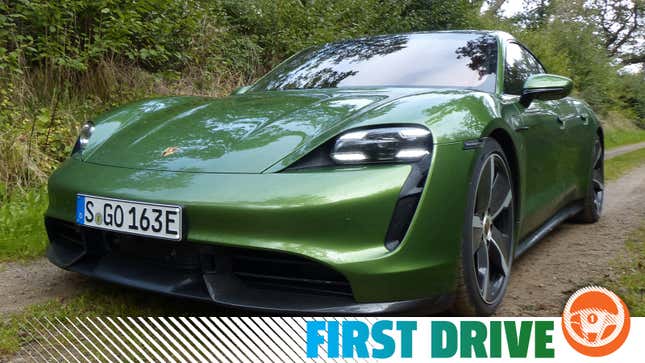
After more than seven years of production, the Tesla Model S finally has another high-performance electric sedan to compete against: the 2020 Porsche Taycan. In Turbo S form, it’s a 750-horsepower all-wheel drive EV that can rocket from zero to 60 mph in 2.6 seconds. It isn’t perfect, but after driving it over 400 miles through Europe, I came away more excited than ever about our electric future.
(Full Disclosure: Porsche flew me from Nuernberg, Germany to Copenhagen, Denmark, fed me fancy food, and put me up in three hotels along the route to Hamburg).
Porsche is in a tricky situation.
The company built its reputation on driving excitement and distinctive character through the sounds and smells of its gas-burning engines. And now, not only will it be expected to offer the same level of emotional response with its EVs, it’s going to have to balance performance with range, a spec that’s going to be a focal point of scrutiny for electric cars as long as the EV charging structure is as limited as it is today.
Porsche will have to rely less on sound, power delivery, acceleration figures, and weight to set itself apart. Zero to 60 mph acceleration times are quickly reaching an asymptote around the mid-two-second range, torque curves of electric motors don’t vary nearly as much as those of ICEs, and the density of batteries means you can expect all near-term EVs to carry quite a bit of heft, specifically between the axles.
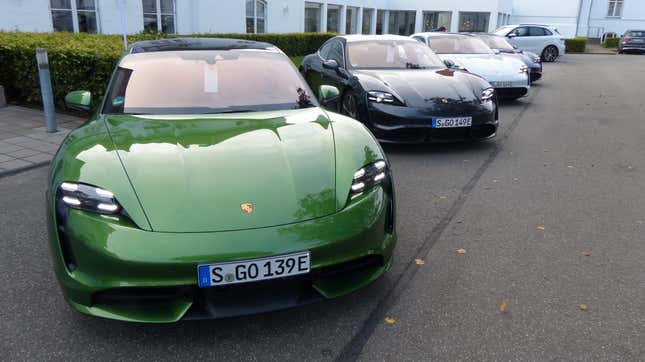
But what Porsche can do—and what it has tried to do with the Taycan—is work within those constraints to build the best-performing car it possibly can. And the result is thoroughly impressive in all areas but one.
What Is It?
The Taycan is Porsche’s first-ever fully electric car. It’s a four-door sedan built on a unique, primarily steel and aluminum architecture with a 1,389-pound battery pack bolted between its axles. That pack contains a 331-pound aluminum battery tray filled with 33 modules, each containing twelve LG pouch cells.
Those cells feed juice to the front and rear drive modules, which each contain a motor and a power inverter. The inverters are tasked with turning the 800 volt direct current from the battery into alternating current to power each axle’s permanent magnet synchronous AC motor.
Porsche says the motor powering the rear wheels makes up to 449 horsepower and 406 lb-ft of torque (or 450 lb-ft during launch with the Turbo S), while the one up front cranks out 238 ponies and 221 lb-ft in the Turbo model, and 255 horses and 325 lb-ft on the Turbo S thanks to a higher amperage inverter.

Both Taycan variants available at the outset, the Turbo and Turbo S, make a total of 616 horsepower outside of launch control. In launch control, though, the former’s 2.5-second “overboost” function allows for 670 horsepower and 626 lb-ft while the latter can make an absurd 750 horses and 774 lb-ft for that short launch duration.
Then there’s what Porsche calls the “highlight of [its] car”: a two-speed automatic transmission. Unlike internal combustion engine cars, most EVs don’t have multiple gears in their transmissions thanks in part to electric motors’ high max RPMs, plentiful low-end torque, and decent efficiency across the rev range. Instead, they use a single roughly 10:1 gear reduction. That is the case for the Taycan’s front drive unit, whose coaxial gearbox integrates a differential and a 8.05:1 reduction.
In the rear, though, Porsche has gone with a more traditional motor setup, which sits parallel and offset to the axle, but what isn’t traditional is the two-speed gearbox with a roughly 16:1 first gear ratio and 8.05:1 second gear.
The idea, Porsche alleges, is that a second gear helps optimize acceleration and top speed performance, and yields better overall efficiency. That last benefit is aided by the Taycan’s ability to open a clutch in the rear transmission to disconnect the wheels from the motor to reduce losses when in front-wheel drive mode.

As for the car’s suspension bits, there’s quite a bit of shared with the Porsche Panamera sedan. Air suspension with variable ride heights is standard; there’s an electromechanical sway bar mechanism to minimize body roll in corners; there are adaptive dampers; and the Taycan sports gigantic brakes like those found on the Panamera, plus rear axle steering and a similar suspension design—an aluminum double-wishbone up front and an aluminum multilink setup out back.
As you might imagine with a new electric car built on a dedicated platform, there’s quite a lot more to the Taycan, so if you want to learn all about it, read my extremely detailed story on the vehicle’s fascinating engineering.
But now it’s time to get to driving impressions.
Inside The Taycan’s Cabin
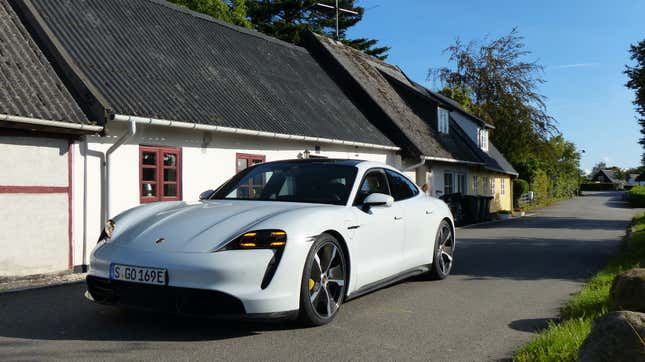
My drive in a white, well-equipped Taycan Turbo S began in Copenhagen, Denmark, and took me on highways, suburban streets, and country roads for a little over 210 miles westward to Børkop, and then another 220-ish miles south across the German border to Hamburg.
My co-driver and I dumped our bags into the medium-sized trunk, and I yanked up on the driver’s door handle, which stood erect in its probably-not-so-aerodynamic position.
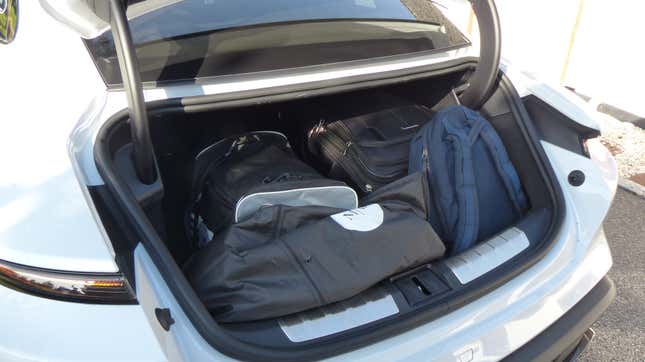
Upon opening the door, I was greeted by a dark cockpit filled with LCD screens. A long and narrow one made up the instrument cluster behind a fairly normal Porsche steering wheel, another rectangular set of pixels sat in the center of the dash and acted as central command for the infotainment system, a screen lay near my right hand along the center console, and another rectangular digitizer was perched neatly in front of my passenger.
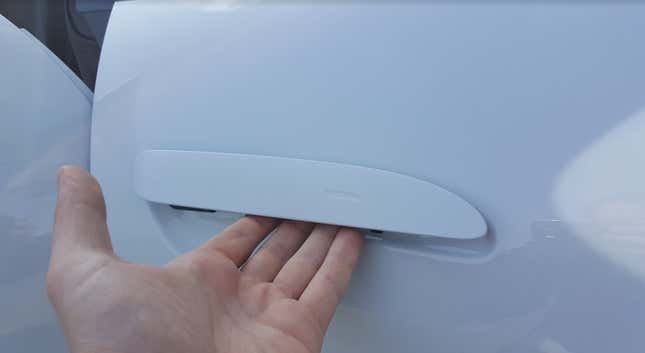
Black leather stretched over almost every surface except for the A-pillars, which were covered in some sort of Alcantara-like fabric.
Despite all the screens and leather, I wouldn’t call the interior opulent. It’s clearly high quality, and both comfortable and elegant, but in a subdued sort of way that tends to be common among German sport sedans.

The slightly less boring interior color, tan, shown below, livens things up a bit:
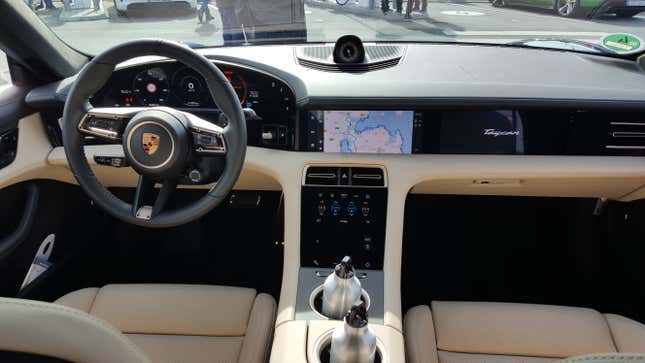
As soon as I sat down in my car’s 18-way power-adjustable driver’s seat, with its extendable thigh support and plentiful side bolstering, I buckled up and felt the slight tug from the car’s automatic seatbelt tensioner.
I pushed the car’s simple and intuitive gold shift lever, situated on the dash to the right of the steering wheel, all the way down until the gauge cluster read “D,” then I maneuvered out of the tight parking spot using the Taycan’s crystal-clear 360-degree camera viewed on the center screen, and hit the road.
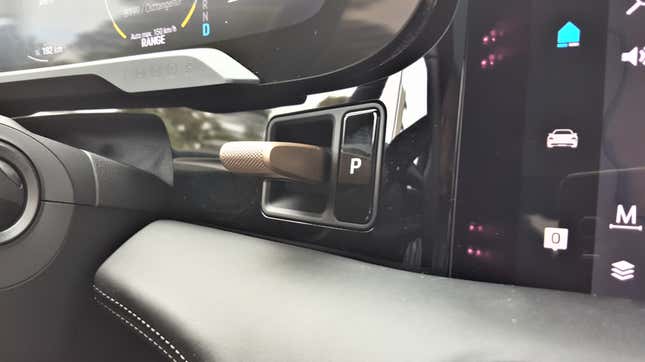
I noticed right away that, when cruising above roughly 30 mph, the motors are virtually silent, and the interior soundtrack consisted only of a bit of road and wind noise.
Only when accelerating or decelerating at low speeds is the sound of the motors obvious, reaching an ever-higher pitch when accelerating, and dropping in pitch (sounding similar to a Wile E. Coyote cliff dive) when the rate of change of vehicle velocity is negative. This is presumably, part of the mandatory-in-the-EU “Acoustic Vehicle Alerting System.”
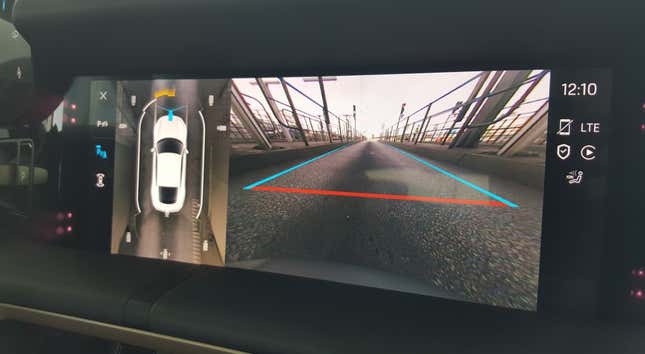
My drive partner and I did have some trouble working the infotainment system. Aside from the shifter and the switches on the steering wheel and doors, most of the Taycan’s buttons are on the four screens on the dash and center console. This means there’s a bit of a learning curve to understanding how to control all of the interior functions.
The volume and HVAC adjustment is on the center console screen (volume is also on the steering wheel), drive modes—which include “Range,” “Normal,” “Sport,” and “Sport Plus”—are accessed via a dial on the steering wheel, and suspension and stability control settings are on the edge of the front gauge cluster screen. We had no issues with these controls, though my codriver and I did regularly struggle with the navigation, and we didn’t quite figure out how to change the regenerative braking to “automatic” without exiting the navigation and going into the settings.
With a bit more time, and with a bit of configuration, the infotainment system could become a lot easier for me to use, but the takeaway here is that working the Taycan’s fancy cockpit takes a little effort to learn.
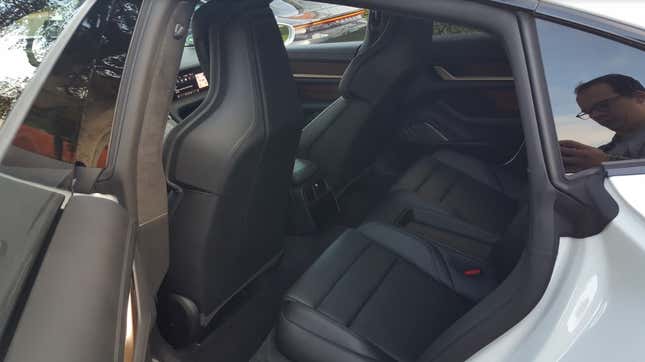
The rear seat is comfortable, with decent head and legroom for me, though I’m only five-foot eight-inches, and I think anyone significantly taller may have some trouble squeezing their head under that sloping rear roof, especially since our car has the glass top.
While we’re on the topic of interior imperfections, check out this open area under the center console:
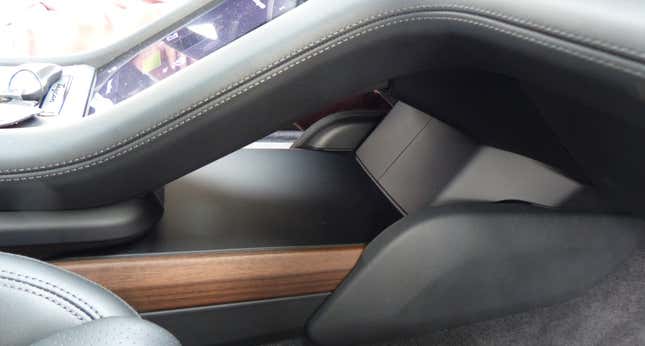
It’s totally useless. Porsche says there will be an optional storage bag to fit into this space, but without that, there’s just an opening with a flat shelf that will toss your expensive digital camera against the floorboard when the driver takes even the slightest turn—ask me how I know.
Still, overall, the interior is a high quality, elegant, comfortable place to spend time, even if all the screens can be a bit much at first.
Acceleration And Top Speed
In the video above, my drive partner, veteran auto writer and friend of the site Lawrence Ulrich, is fast asleep in our white Taycan Turbo S’s passenger’s seat. I dropped the car into Sport Plus Mode, then stepped on the brake and accelerator pedal to activate Launch Control, which is needed to unleash the car’s full 750 HP.
As soon as I released the brake, the Taycan’s two motors were fed loads of current from the battery through the inverters, accelerating all four wheels as their Goodyear Eagle F1 tires gripped the asphalt and rocketed the car forward with a thrust I’d never experienced before in a production automobile.
As you can see, the longitudinal acceleration woke Lawrence up immediately, which is not surprising. Because aside from that fun joke on the poor tired auto journalist, he and I both had to warn one another anytime we planned to push the accelerator pedal with any significant force.
“Put your head back, I’m going to hit it,” I began telling him after having neglected to do so the first time and feeling guilty about banging is head so hard into the headrest.
The Porsche Taycan is, in a straight line, an absolute monster.
The acceleration doesn’t stop. Even at Autobahn speeds, banging the right pedal yields so much torque at the wheels that it really doesn’t take a whole lot of road to get the Taycan up to its 161 mph top speed.
Actually, we were able to get the car up to 166.5 mph, so it seems that Porsche’s top speed number is a bit conservative.
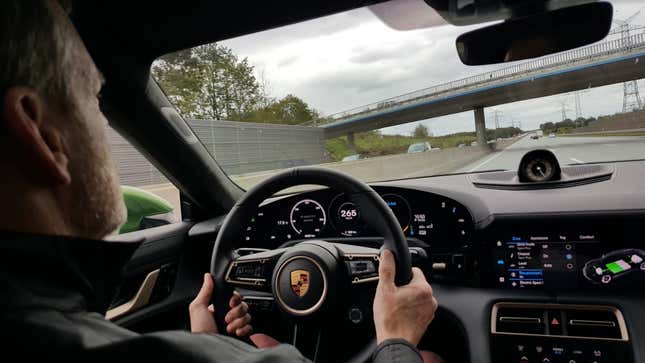
As for the sound you hear in the video above on the inside of the cabin, that’s called Porsche Electric Sport Sound, and it’s essentially a synthetic “motion” sound produced by the vehicle’s speakers. Even without that function on, there’s some motor noise when accelerating hard from a stop; the Electric Sport Sound cranks the volume up a bit, but it definitely doesn’t feel over-the-top.
If you’re used to hard accelerations being accompanied by the roar of an internal combustion engine, you’ll likely find the Taycan’s sound to be a bit tame. I myself enjoyed it, and kept it on for much of the drive.
One thing that was a bit odd about the sound was that it seemed like, when slowing down in Sport Plus mode, the car “blipped its throttle,” cranking up the noise for just a second in what sounded like a downshift.
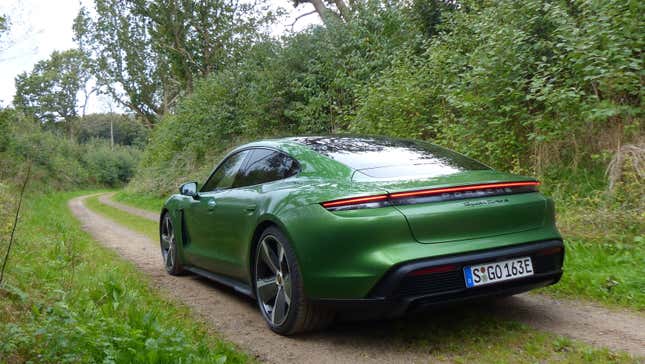
Speaking of shifts, the thing I was most interested in learning about the Taycan was how that two-speed transmission behaved. I kept trying to get the thing to shift so I could experience for the first time the feeling of an EV shifting. The easiest way I was able to do this was to put the car into “Sport” mode, and then coast down below 50 km/h. That’s when I noticed a downshift. Then I touched the accelerator pedal and sped up past 80 km/h, and that’s when I felt a distinct upshift.
The shifts weren’t as buttery smooth as some conventional torque converter automatics, with the downshift especially yielding a distinct “clunk” and a slight vehicle shudder. I wouldn’t call it harsh, especially since I had to drive a very specific way to notice the shifts at all.
One thing I did notice early on was that, when in “Range” mode, if I hammered the throttle, there was a tiny bit of hesitation before the electric thrusters shot the Taycan down the street.
Whether this was because of a downshift, I’m unsure, but in Sport and Sport Plus mode, hammering the throttle brought instant punishment to my neck muscles.
Ride And Handling

The Porsche Taycan is a ridiculously heavy sedan, weighing in at over 5,100 pounds, or more than a well-equipped SuperCrew Ford F-150. And while that’s a scary thing to hear when you’re talking about a performance car, the reality is that Porsche has been in the business of making heavy cars handle well for years now—see also the Porsche Cayenne, Macan, and Panamera.
While I won’t pretend to be an expert when it comes to vehicle dynamics or chassis design, I will say that the Taycan impressed me with the way its nose darted into a turn as soon as I moved the steering wheel. Though I can’t say the wheel gave me much tactile information about the front tires’ grip, the steering feels direct and precise, and the grip from the wide, but still rolling resistance-optimized, tires (265 section up front, 305 out back) was damn good as I whipped the big sedan around tight bends on highway onramps.
The car’s weight isn’t imperceptible, especially during quick left-right transitions, but body roll is basically zero, and even at high Autobahn speeds, the car feels stable and quiet, and the ride quality is good.
I didn’t really test the car’s limits, since I was driving on public roads, but I did hit some roundabouts quite hard, and the vehicle gripped well, though my codriver did enter one traffic circle too hot, and the car seemed to understeer quite a bit.
But fret not, because I put the Taycan into Sport Plus mode, turned off the traction control, and smashed the electron pedal around a U-turn in Denmark. The result was a lot of wheel spin, the tail end stepping far out, and me rapidly countersteering to get the nose pointed in the right direction.
As I experienced when I attended the Taycan’s technical workshop about a month ago, it is not difficult to drift the Taycan and have a lot of fun doing it.
Regenerative Braking
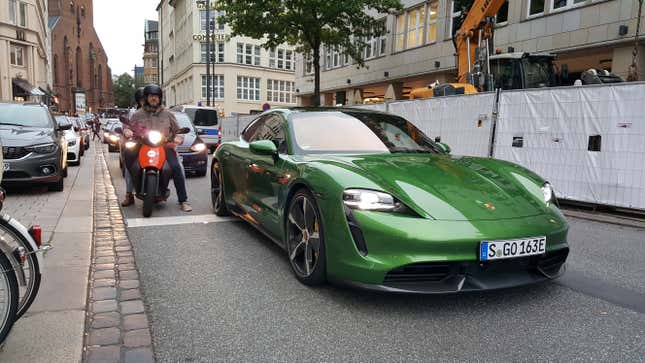
Porsche does regenerative braking differently than some other EV makers.
Pressing the brake pedal first activates the regenerative braking, which uses the vehicle’s kinetic energy to spin up the motors, which act as generators to fill the high-voltage battery. Under especially hard braking, the 10-piston calipers up front and four-piston calipers out back clamp the rotors to scrub some of the speed off into heat.
But that’s just when lift-off recuperation is in the “off” mode; turning it to “on” via the button on the steering wheel allows the driver to decelerate the car simply by letting off the accelerator pedal. But don’t expect this to feel like “one-pedal driving” you’ve experienced in a Tesla or a Chevy Bolt, because the regen is quite subtle, feeling a bit like the drag from a conventional ICE car’s drivetrain.

There is one mode that does allow for true “one-pedal driving,” and that’s “Auto.” This setup uses a camera at the nose of the car to detect traffic ahead, and thus it determines that instead of coasting, it makes sense to apply the brake regen when the driver lets off the accelerator pedal. Based on my experience in the Taycan, the auto mode seemed to apply a stronger regen-induced deceleration than when the system was simply in “on” mode.
Still, I think it’d have been cool if Porsche had allowed some level of adjustment to the regen system so I could have one-pedal driving even when outside of “auto” mode. I also noticed that, when the regen was off and the vehicle was coasting at low speeds, I felt a slight vibration and a low bass sound in the cabin. Turning regen on or tapping the accelerator put an end to this vibration, the origins of which I frankly do not know.
Charging And Range

“Please recharge battery immediately” the gauge cluster read as Lawrence and I drove down the Autobahn at speeds reaching over 130 mph. We were in “Sport” and “Sport Plus” mode much of the drive, but aside from a couple of short high speed runs not unusual for the Autobahn, as well as a few launches, we’d been driving rather conservatively for about 190 miles after starting with 92 percent state of charge. So we were a bit surprised to see the navigation screen telling us that our Mamba Green Taycan would arrive at the charger with 0 percent battery remaining.
The Taycan, with its 93.4 kWh lithium-ion battery pack, is rated at up to 280 miles of range on the European WLTP cycle, but the Taycan Turbo S model we were driving is only rated to do 256. That’s quite a bit lower than the Tesla Model S’s rating of up to almost 380 miles on the same cycle, and it almost caused problems for us.
Lawrence really wanted to hammer down to test the top speed, since we’d just entered the Autobahn from Denmark, where highway speeds were limited to about 81 mph, but he resisted to avoid us having to deal with the car dropping into limp mode.
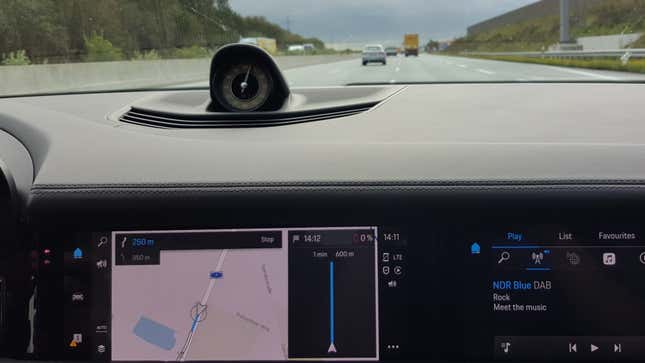
We arrived at the station with only about four miles of range left, or 1 percent battery state of charge. We’d averaged a usage of 23.6 kWh per 100 kilometers (or about 380 Wh per mile) at an average of 37 mph over the 190 miles traveled.
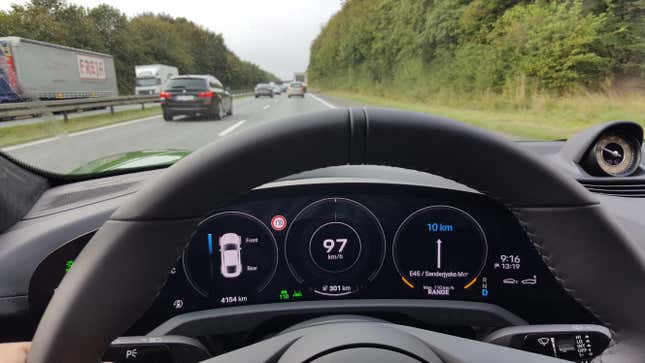
In Range Mode, the Taycan decouples the rear drive module, and drives the car only with the front wheels, as shown in the leftmost gauge in the cluster above. Staying in this mode, and driving conservatively at an average of 37 mph on back roads for 62 miles, we were seeing about 21 kWh used per 100 km (or 338 Wh/mile), and at a steady-ish 80 mph, it was closer to about 22.1 (or 356 Wh/mile).
These are extremely unofficial figures and not at all controlled, but if you’re curious how much energy other EVs use to drive a certain distance according to EPA testing, check out this article from Inside EVs.
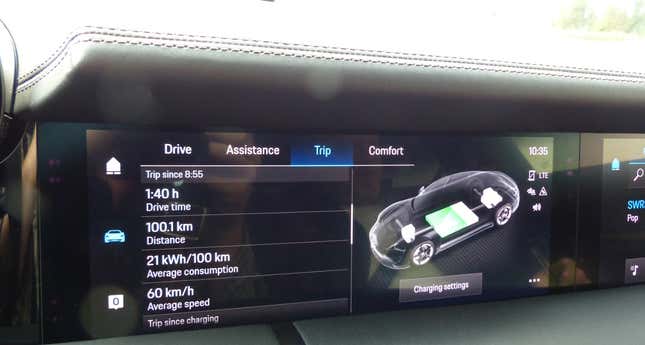
I spoke with Porsche about the range delta between the Taycan and the Tesla Model S. Part of it, it’s safe to say, has to do with the smaller battery pack (of which over 90 percent is actually usable, Porsche claims), but I was also curious to know why the Porsche might use more energy to go down the road despite having a lower 0.22 drag coefficient on the Turbo (the Turbo S has a Cd of 0.25) and only a bit more weight. He told me that the Taycan’s wider tires may be a significant factor.
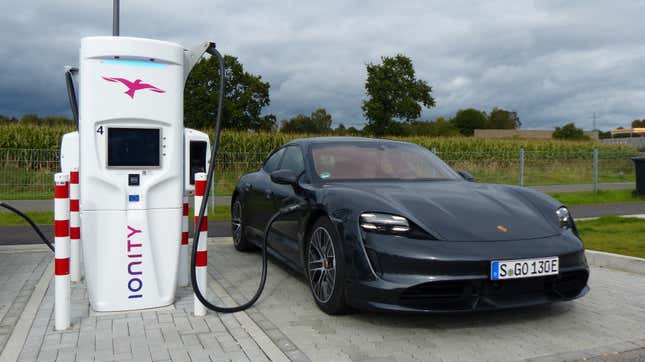
The good news is that, even though the Taycan doesn’t offer a ton of range, its battery charges up incredibly quickly. Well, once you find a good charging station that is.
Lawrence and I pulled up to an Ionity station with our battery at 1 percent charge. I swiped my finger under the black “fin” just to the left of the charging port door, and the door opened up. Then I pulled the plastic flap you see below down a bit, I shoved the charger in, and the light to the right of the plug began blinking white, indicating that the car was communicating with the charger. Porsche’s people swiped a payment card at the machine, and the light began blinking green, indicating that the battery was filling.
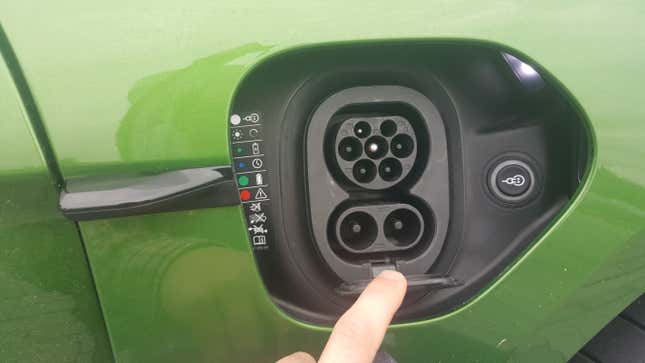
Unfortunately, we ran into a little issue: The station wasn’t putting out its full juice. Our vehicle, rated to accept 270 kW (at the ideal battery state of charge and temperature, which was about 30 Celcius) was down to about 110 to 140.
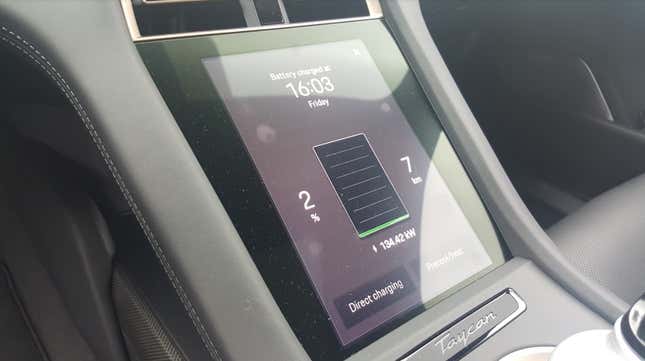
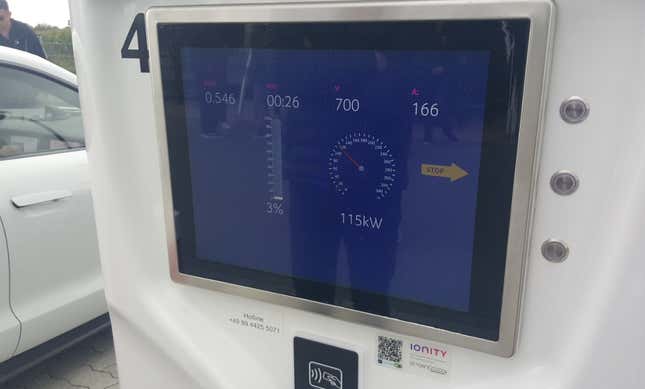
After charging up for just a few minutes, the battery was at eight percent when we decided to swap chargers. The output from the new cable was much higher, reaching over 260 kW once the battery state of charge had reached about 20 percent, and staying around 200 kW after 30 percent, and tapering thereafter until it reached around 75 kW at 80 percent state of charge. That’s when we unplugged the car after only about 20 minutes of charging.
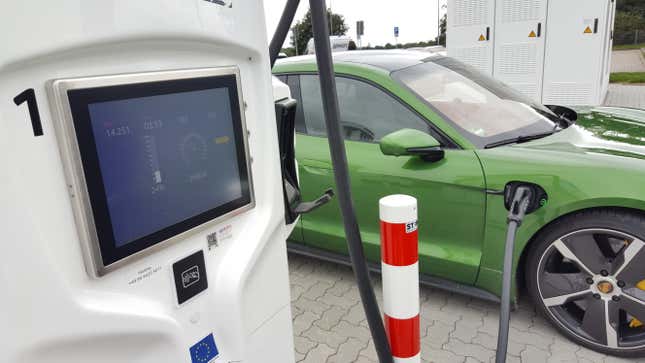
So, eight percent (or just under 20 miles of indicated range) to 80 percent (or about 170 miles of indicated range) in just over 20 minutes. Not bad.
How Does It Compare To The Tesla Model S?
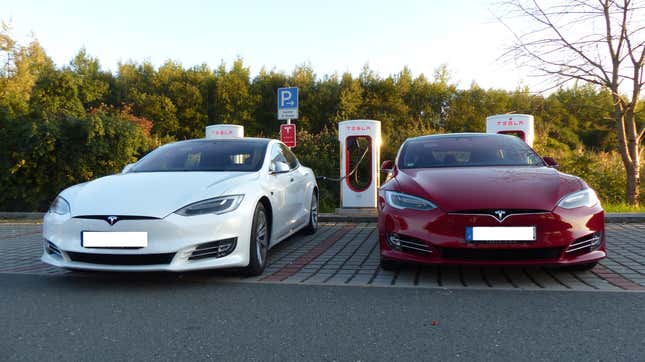
We can debate all day whether the $150,900 Porsche Taycan Turbo and $185,000 Turbo S compete directly with the $79,990 Tesla Model S Long Range and $99,990 Tesla Model S Performance. But the reality is that the Model S is currently the benchmark for large electric performance sedans, so I had to find a way to compare the two.
Unfortunately, I hadn’t driven a Tesla Model S since 2014, so I drove to a Supercharger near where I’m staying in Germany, and met some owners. One gentleman gave me a full tour of his dual-motor Model S Long Range. Obviously, the “Performance” model would be a bit more of a direct competitor with the Taycan, but I still gained some good insights.
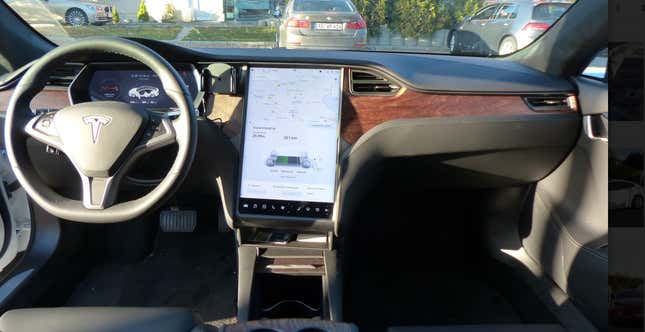
The Tesla interior is quite nice. I don’t think it’s quite as sexy as the Porsche’s cabin, but it’s still elegant enough considering the price delta, and I thought the material quality was decent. Tesla’s definitely paved the way with the giant tablet screen, which lots of automakers have adopted since.
Have a look for yourself:

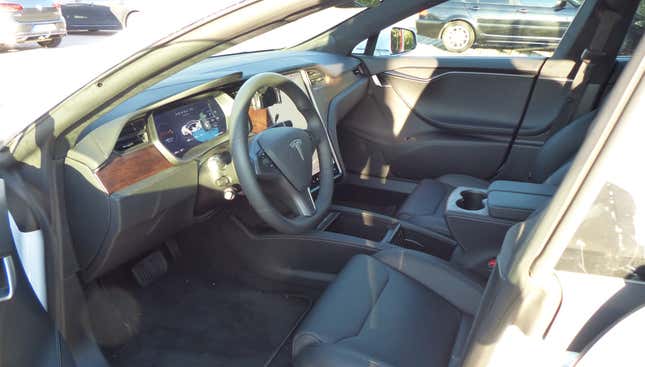
I also noticed that the Model S had a gigantic cargo area compared to the Taycan, which isn’t surprising since the Model S is a hatchback. Here’s the Model S:

And here’s the Taycan:
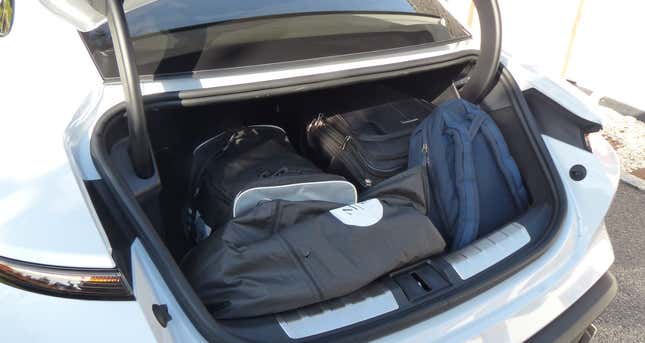
The Taycan has a small space under the load floor, but it’s nowhere near as big as the huge under-floor bin that the Tesla has:

As for the frunk, the Tesla’s is wider, but shallower. Here’s the Tesla’s frunk:
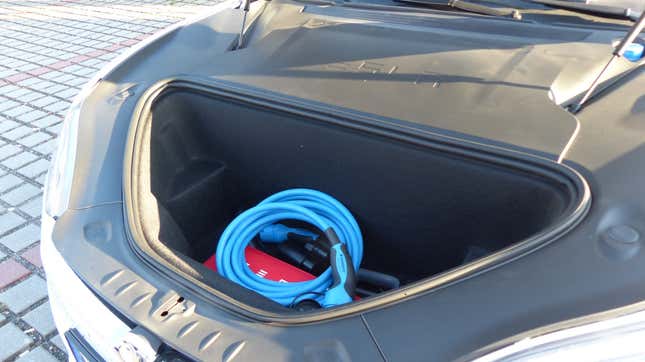
And here’s the Taycan’s frunk:
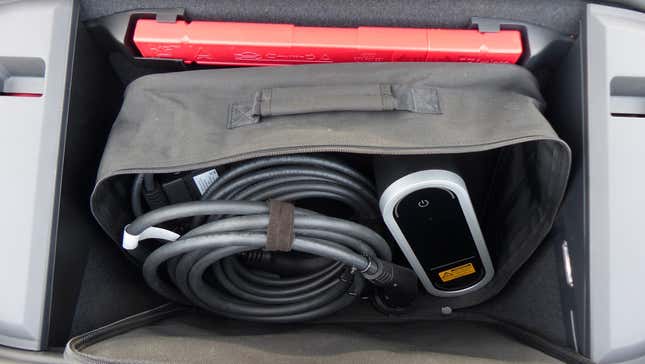
The Model S owner also pointed out to me on his infotainment screen how impressive Tesla’s charging infrastructure is:
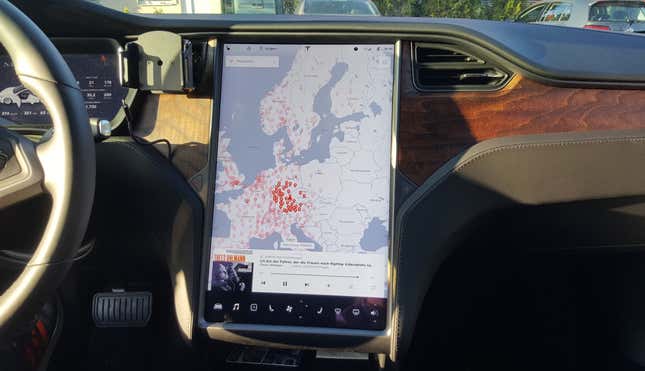
I see this as a major advantage for the Tesla, as when it comes to fast charging, Porsche simply pointed out Ionity’s plans to have 400 charging points set up by 2020 (Tesla, on its website, says it has over 1,600 Supercharging stations predominantly in Europe but also in the middle east):
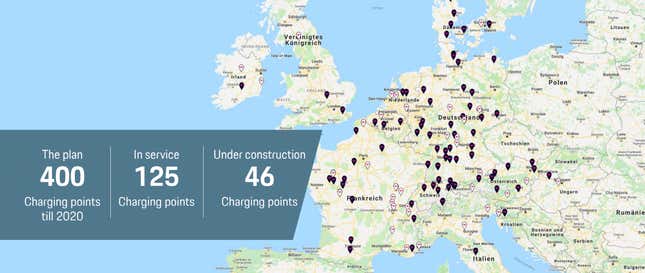
As for charging rate, the Tesla owner told me he’d see as high as 147 kW, and that a Supercharger gets him about 190 miles in half an hour. His vehicle screen displayed that he had been using 20 kWh/100 km over the last 151 miles of driving, which is a bit better than the 21 I was seeing when driving slowly in the Taycan. (Just keep in mind the driving conditions weren’t the same, so it’s really not an apples-to-apples comparison).
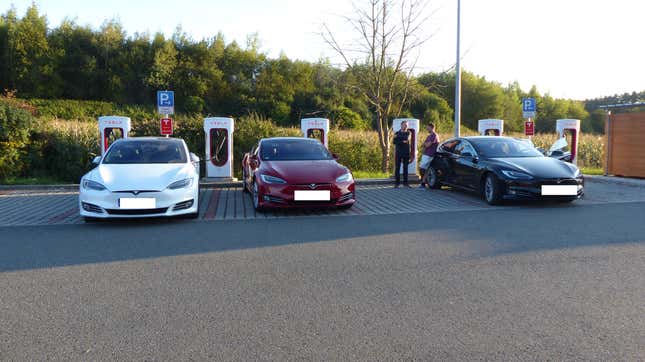
The Long Range Model S owner was kind enough to let me behind the wheel for a few minutes. While this wasn’t nearly enough time to fairly compare it to the Taycan I had just driven, especially considering I drove the vehicles in different driving conditions, I will say that my initial impression was that the Model S’s cabin was a bit less isolated from the road (i.e. noisier) than the Porsche’s. Since this wasn’t the Performance model, it was quite a bit slower, though the power delivery was, naturally, the same, and it would impress darn near anyone who hadn’t just stepped out of a Porsche super sedan.
The visibility out of the front was, like the Taycan, excellent, and also like the Taycan, the view out of the rear was bad.
As for handling, based on my short drive, it appeared to me that the Porsche’s steering was more direct, with the car seeming to respond more quickly to wheel inputs, though again—take this with a grain of salt since my drive in the S was so short.
One thing is clear even based on my short drive, and that is that the Model S is a hell of a machine. The fact that I’m not saying it felt cheap compared to the much more expensive Taycan is impressive any way you look at it.
We will have to get more seat time for a more direct comparison between the two soon.
The Taycan Has Brought More Excitement To The EV World

Whether you’re a Tesla fan or not, and whether you can live with a vehicle with the Taycan’s range, the reality is that the new Porsche super sedan is another reason to get excited about the world of EVs.
Tesla and Porsche are in a slugfest over Nürburgring lap times and based on how many people are reading our stories on that, people are clearly amped about this. Even in the real world outside of the internet, there’s a lot of Taycan energy in the air.
Everywhere I drove in my Mamba Green test car, it felt like the world was watching. People waved from overpasses as we drove by. One man in Hamburg walked with us as my copilot and I crawled in traffic, asking endless questions about the incredible green Porsche he’d only seen pictures of on the internet. I’m sure the car is extra notable on its home turf, but that excitement was great to see and feel.
One remarkable moment happened when my co-driver went down a street with two bus stops positioned across from each other. We passed by and the children stared, then we turned around after the wonky navigation system sent us in the wrong direction, and all the children on both sides of the street literally cheered and waved. I’d never seen anything like it.
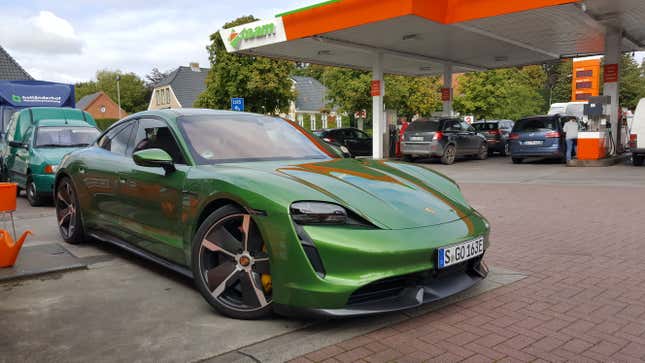
I even gave a Porsche owner a ride in Hamburg after he approached my window, told me about his 992 Porsche 911, and gazed in amazement at the Taycan.
“How are you driving this? These aren’t out yet, are they?” he told me. He asked to sit inside, and hit me with dozens of questions before a bus pulled beside the car and honked. I was parked illegally at a bus stop waiting for my co-driver to come back from the bathroom, and I had to move. “Hey, buckle up,” I told him, “we’re going for a ride.”
The man, probably in his mid-40s, called his daughter, whom he was ditching at the mall to go for a ride with a stranger in a preproduction Taycan. “You won’t believe it. I’m in the new Taycan!” he yelled. “Look, turn to your left. I’m in that car!” he continued.
I came to a stoplight, dropped the car into Sport Plus, engaged launch control, and blew his mind.